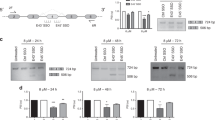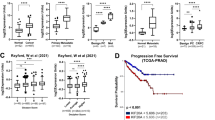Abstract
The regulatory (R) subunits of cAMP-dependent protein kinase (PKA) are implicated in the regulation of cell proliferation and differentiation. There are two isoforms of PKA that are distinguished by two types of R subunit, RI and RII. Evidence suggests that RI is associated with proliferation and RII is associated with cell differentiation. Previous work in this laboratory has demonstrated that depletion of the RIα subunit by treatment with an antisense oligonucleotide (ODN) induces differentiation in leukemia cells and growth arrest and apoptosis in epithelial cancer cells. Using the prostate cancer cell line PC3M as a model system, we have developed a cell line that overexpresses a retroviral vector construct containing the RIα antisense gene. This cell line has been characterized and the effectiveness of the construct determined. In the work presented here, we demonstrate by immunocytochemistry that treatment with RIα antisense ODN induces translocation of the Cα subunit of PKA to the nucleus of PC3M prostate cancer cells. The translocation of Cα triggered by exogenous antisense ODN treatment mirrors that observed in cells endogenously overexpressing the antisense gene. Triggering the nuclear translocation of the Cα subunit of PKA in the cell may be an important mechanism of action of RIα antisense that regulates cell growth independent of adenylate cyclase and cellular cAMP levels. The nuclear localization of the Cα subunit of PKA may be an essential step in revealing the mechanism whereby this critical kinase regulates cell growth.
This is a preview of subscription content, access via your institution
Access options
Subscribe to this journal
Receive 50 print issues and online access
$259.00 per year
only $5.18 per issue
Buy this article
- Purchase on Springer Link
- Instant access to full article PDF
Prices may be subject to local taxes which are calculated during checkout




Similar content being viewed by others
References
Arias J, Alberts AS, Brindle P, Claret FX, Smeal T, Karin M, Feramisco J, Montminy M . 1994 Nature 370: 226–229
Beebe SJ, Corbin JD . 1986 The Enzymes: Control by Phosphorylation Academic Press: New York
Bold RJ, Alpard S, Ishizuka J, Townsend Jr CM, Thompson JC . 1994 Regul. Pept. 53: 61–70
Bradbury AW, Carter DC, Miller WR, Cho-Chung YS, Clair T . 1994 Br. J. Cancer 69: 738–742
Budillon A, Cereseto A, Kondrashin A, Nesterova M, Merlo G, Clair T, Cho-Chung YS . 1995 Proc. Natl. Acad. Sci. USA 92: 10634–10638
Chen HX, Marshall JL, Ness E, Martin RR, Dvorchik B, Rizvi N, Marquis I, McKinlay M, Dahut W, Hawkins MJ . 2000 Clin. Cancer Res. 6: 1259–1266
Cho YS, Kim M-K, Cheadle C, Neary C, Becker KG, Cho-Chung YS . 2001 Proc. Natl. Acad. Sci. USA 98: 9819–9823
Cho-Chung YS . 1990 Cancer Res. 50: 7093–7100
Cho-Chung YS . 1998 Applied Antisense Oligonucleotide Technology. Stein CA and Krieg AM (eds) Wiley-Liss: New York
Cho-Chung YS, Clair T, Tagliaferri P, Ally S, Katsaros D, Tortora G, Neckers L, Avery TL, Crabtree GW, Robins RK . 1989 Cancer Invest. 7: 161–177
Constantinescu A, Diamond I, Gordon AS . 1999 J. Biol. Chem. 274: 26985–26991
Dohrman DP, Diamond I, Gordon AS . 1996 Proc. Natl. Acad. Sci. USA 93: 10217–10221
Kwok RP, Lundblad JR, Chrivia JC, Richards JP, Bächinger HP, Brennan RG, Roberts SG, Green MR, Goodman RH . 1994 Nature 370: 223–226
Levin A . 1999 Biochim. Biophys. Acta. 1489: 69–84
McDaid HM, Cairns MT, Atkinson RI, McAleer S, Harkin DP, Gilmore P, Johnston PG . 1999 Br. J. Cancer 79: 933–939
McGeady ML, Kerby S, Shankar V, Ciardiello F, Salomon D, Seidman M . 1989 Oncogene 4: 1375–1382
Miller WR, Hulme MJ, Cho-Chung YS, Elton RA . 1993a Eur. J. Cancer 29A: 989–991
Miller WR, Watson DMA, Jack W, Chetty U, Elton RA . 1993b Breast Cancer Res. Treat. 26: 89–94
Montminy M . 1997 Annu. Rev. Biochem. 66: 807–822
Montminy MR, Bilezikjian LM . 1987 Nature 328: 175–178
Montminy MR, Sevarino KA, Wagner JA, Mandel G, Goodman RH . 1986 Proc. Natl. Acad. Sci. USA 83: 6682–6686
Nesterova M, Cho-Chung YS . 2000 Antisense Nucl. Acid Drug Devel. 10: 423–433
Nesterova M, Noguchi K, Park YG, Lee YN, Cho-Chung YS . 2000 Clin. Cancer Res. 6: 3434–3441
Schiavone N, Papucci L, Luciani P, Lapucci A, Donnini M, Capaccioli S . 2000 Biochem. Biophys. Res. Comm. 270: 406–414
Seamon KB, Padgett W, Daly JW . 1981 Proc. Natl. Acad. Sci. USA 78: 3363–3367
Simpson BJB, Ramage AD, Hulme MJ, Burns DJ, Katsaros D, Langdon SP, Miller WR . 1996 Clin. Cancer Res. 2: 201–206
Srivastava RK, Lee YN, Noguchi K, Park YG, Ellis MJC, Jeong J-S, Kim SN, Cho-Chung YS . 1998 Proc. Natl. Acad. Sci. USA 95: 6687–6692
Tortora G, Cho-Chung YS . 1990 J. Biol. Chem. 265: 18067–18070
Tortora G, Yokozaki H, Pepe S, Clair T, Cho-Chung YS . 1991 Proc. Natl. Acad. Sci. USA 88: 2011–2015
Wang H, Cai Q, Zeng X, Yu D, Agrawal S, Zhang R . 1999 Proc. Natl. Acad. Sci. USA 96: 13989–13994
Yamamoto KK, Gonzalez GA, Biggs III WH, Montminy MR . 1988 Nature 334: 494–498
Young MRI, Montpettit M, Lozano Y, Djordjevic A, Devata S, Matthews IP, Yedavalli S, Chejfec G . 1995 Int. J. Cancer 61: 104–109
Zhao Q, Yu D, Agrawal S . 1999 Bioorg. Medicinal Chem. Lett. 9: 3453–3458
Acknowledgements
We thank Dr S Agrawal (Hybridon, Inc. Milford, MA, USA) for providing the RIα antisense oligonucleotide and the control oligonucleotide. The plasmid OT1529-RIα antisense gene was constructed by Dr Langzhu Tan, and the PC3M cell line stably transfected with the OT1529-RIα antisense gene vector was developed by Dr Yee Sook Cho, in our laboratory. Dr Frances McFarland, of Palladian Partners, Inc., provided editorial support under contract number N02-BC-76212/C2700212 with the National Cancer Institute.
Author information
Authors and Affiliations
Corresponding author
Rights and permissions
About this article
Cite this article
Neary, C., Cho-Chung, Y. Nuclear translocation of the catalytic subunit of protein kinase A induced by an antisense oligonucleotide directed against the RIα regulatory subunit. Oncogene 20, 8019–8024 (2001). https://doi.org/10.1038/sj.onc.1204992
Received:
Revised:
Accepted:
Published:
Issue Date:
DOI: https://doi.org/10.1038/sj.onc.1204992



